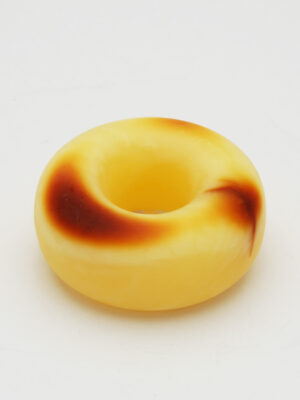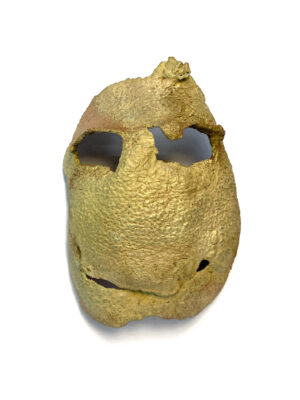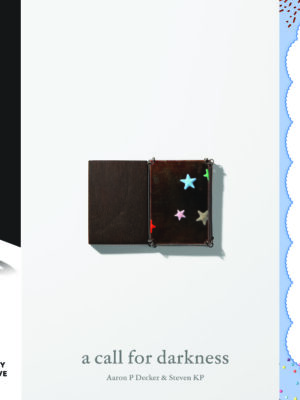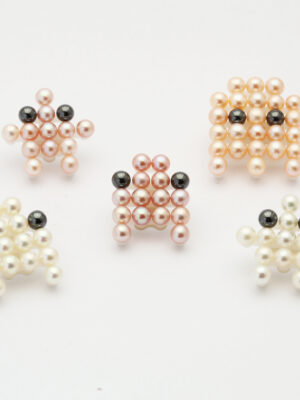Bella Neyman:
For me, Munich is really important because while I treat it as an opportunity to see what is coming up in the field, I also look at it as an opportunity to familiarise myself with the canon, like the history of contemporary jewellery. Being in the US, we’re obviously not often exposed to a lot of the European jewellers, who really helped shape the field, thus this exposure is crucial for me. Taking that into consideration, I would absolutely go see the Otto Künzli show at Gallery Wittenbrink. And, of course, make it a priority to see Dorothea Pruhl at Frame. I would also visit the show at Ping Rodach Contemporary. It’s a show that features Hermann Junger’s work, but also Denise Reytan, and Sam Tho Duong, whose work I love.
Also, I’m a big fan of Japanese contemporary jewellery. I went to Japan last year, and I would absolutely go see the exhibition Contemporary Jewelry Symposium. Under the stairs, it seems that it is also a Japanese school that is exhibiting this year, being curated by Mari Ishikawa, Fumiki Taguchi, Itto Mishima, and Takashi Kojima. Actually, in the field right now, I think what’s happening in Japan is extremely interesting because there’s this duality between, like a very lean Japanese aesthetic, but also this move towards almost like a neo-baroque- very ornate, employing new technologies, very much inspired by antique jewellery. Which is interesting because the history of jewellery in Japan is very different than in any other country in the world, only because they didn’t regard jewellery as really adornment unless it was part of their ceremonial attire. And so, they’re almost writing jewellery history at the moment. It’s really interesting. Then, I always have my favourites, like the things that I go to every year. So, I always love the exhibitions at Gallery Handwerk. I think they’re always the most solid, and there is a new curator there this year. Also, one of my favourite jewellery curators is Christian Hödel (Gallery Florian Specht). He always does really wonderful shows. He has a great eye, and always presents work that is just always very strong, and it’s always a selection of artists, both new and old. So, I’m really excited for his show. The show Short Stories with Kim Buck and Peter Bauhuis is also something that I think should not be missed. Misha Khan (Kunst 66), definitely one that I would not miss. I love that he goes seamlessly between jewellery and decorative arts and design, and he is able to work on a large scale as well as small. He hasn’t made jewellery in a really long time. So the fact that this is his first jewellery-only show in Europe is really exciting.


MM: Can you speak a bit more about what it is you look for at Munich Jewellery Week? You mentioned it’s an opportunity to see the canon of contemporary jewellery history; what else do you prioritise and why?
BN: For instance, the thing with Dorothea (Pruhl) is that she really only makes about one piece a year. I’m not sure what she’s showing, but I would imagine it’s likely to be a mix of new and old work, which is a rare treat. From what I understand, when she creates pieces, they typically go to collectors immediately. So, having the chance to see a complete body of work in one place is very special. Another highlight for me at the convention centre is Talente. I find Talente more exciting than Schmuck because, first of all, I love that it’s not just about jewellery but includes interdisciplinary objects and jewellery. It’s an international showcase, and the work is often very exciting. There’s something about fresh talent who’s not afraid to experiment with materials and forms. You get the sense that they are kind of like the best of the best. Not that they’re not at Schmuck, but Schmuck tends to feature the same people.
However, Talente is different. The participants are under the age of 35, so it’s not like they can keep applying, and I’ve never seen work repeated. It’s fascinating because many start at Talente and then go on to achieve great things. Watching their careers evolve is really interesting. I always find it surprising, daring, and really good.
But there’s always that sense with Talente that, if they continue to develop their work, they might be part of these larger international craft competitions in a few years.
MM: In comparison to New York Jewelry Week, would you say Munich is less commercial and more experimental?
BN: Yes, absolutely. I often find myself questioning the nature of certain pieces, pondering, ‘What is this?’ or ‘Who’s going to wear this? Is this actually jewellery?’ I understand that this perspective might be a bit passé, as there’s a push to transcend traditional definitions of jewellery that go beyond the body. I appreciate those concepts, but perhaps due to my experience with New York City Jewelry Week, I tend to appreciate jewellery in a more traditional sense. The way I define jewellery is that it is adornment. And that it has to be on the body.
It doesn’t necessarily have to be crafted from traditional materials, but it should be an expression of self. It can still be narrative, reflecting the story of the jeweller, but it needs to be wearable. So, when I encounter pieces at Schmuck, I often wonder, ‘Who is the buyer?’ This question is crucial to me because it also touches on the longevity of the field.
And so I think that in many ways, while we could speak about, “Is it an art form?”- That’s not the conversation, it is absolutely the art form. And I’m not talking about, that it has to be made from gold either. But I think about who’s consuming this. And most people who consume jewellery, for them, it does have to serve a purpose of being on the body. Or, when I see things, and don’t always find the work to be well made. I think that is of utmost importance, right? You don’t have to be a world-renowned goldsmith, but you do have to be able to, you know, craft a piece of jewellery, right? You have to have the skills and the know-how and then you can subvert it. And I think that’s the beauty in it too. But I think a lot of things in Munich: “Who’s buying this? Is it well made? What is it saying?” I think about that all the time- ‘What is this artist saying? And is this a story that the person who’s consuming this will want to carry with them?’ Because I think that’s really important as well. ‘Is it innovative or has this been done before?’ And oftentimes, ‘Is this actually something that this person is going to continue making, once they’re out of school and trying to make some sort of living?’

MM: Would you say that would be your burning question for the field – who is buying and who is consuming?
BN: Yes, absolutely. Because, I mean, we need to figure out how to sustain the field. But then, maybe Munich is the place where you kind of don’t have to think about that. Maybe that’s how it differs, right? From the other jewellery weeks, or at least New York, maybe you don’t have to worry about whether people are buying it because are people really buying in Munich? I’m not saying they’re not, but I’m also not saying they are. I think maybe it’s okay to be more experimental and to really have fun and to dive into your practice in a way that you wouldn’t if you were thinking about showing this with a gallery. So maybe a lot of these shows are just… You know you’re doing it for your soul, and that’s good too! I just know that in New York, I couldn’t show 90% of this because, again, I would have a hard time making a case for why this is jewellery. Whereas in Munich, it’s really, I think, for the field. And there, we’re more speaking to ourselves. We’re not really trying to talk to anyone else.
MM: Maybe that is part of what’s useful about it, that you get that moment for consensus? If these conferences serve different purposes, this is the one where we can actually try to have a conversation amongst the entire field?
BN: Exactly. But I am curious though, to be honest with you, as to why there’s so many artists who are not showing. Europeans, and actually, even Americans. I also don’t see a lot of work being shown by those artists of, kind of my generation from the Academy, a lot of the artists who would show regularly.
But I also don’t know if maybe it’s because many of them are now teachers… ?

MM: That is another huge conversation, isn’t it, about the teaching artists? How much time does it actually leave them to make new work? I’m very curious about that.
BN: And that is definitely a conversation you can have with JV Collective. In fact,
There really is only one American show, and it’s three shows:
3 x USA: Unfamiliars/a call for darkness/Tasty- JV Collective, Aaron P Decker & Steven KP, and students of Massachusetts College of Art and Design, Metropolitan State University of Denver, Towson University, Tyler School of Art and Architecture)
In the JV Collective, I think they’re all educators and having had to focus on their coursework, this is the first time they’re coming to Munich since 2019, so I’m glad to see them finally coming back this year.
But otherwise I don’t really see any American work being shown.
Oh, there’s one other thing I forgot to mention, which will be a cool show: Helen Britton is cleaning out her studio. So it’s her, David Bielander, and Yutaka Minegishi. They’re basically just doing a sale of all the stuff in their studio.
MM: Everything must go?
BN: Yeah, so don’t miss it!
Bella Neyman is an independent curator and journalist specialising in contemporary jewellery, and co-founder of New York City Jewelry Week. With a Master’s Degree in Decorative Arts and Design History from the Cooper Hewitt, Smithsonian Design Museum & Parsons, The New School for Design in 2008, she is a resounding voice and a must-read advocate for contemporary jewellery. With affiliations in some of New York City’s leading design galleries and on the board of Art Jewellery Forum, her articles have been published in The New York Times, American Craft, and the Magazine Antiques as well as many others.
This interview is part of the Pulse series, highlighting the favourite Munich Jewellery Week selections of professionals in the field. For more Pulse articles by Jimena Rios, Lin Cheung and Oh My Blue Gallery, order the Munich Jewellery Week Paper 2024 now through our webshop.



